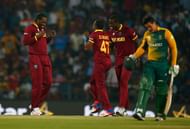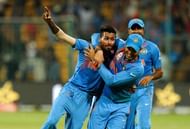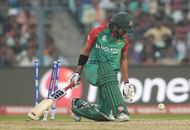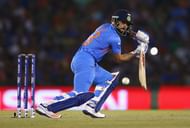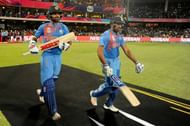The Super 10 Stage of the ICC World T20 concluded last night with South Africa securing an easy 8-wicket win over Sri Lanka. At the end of the Super 10’s, West Indies and England from Group 1 and New Zealand and India from Group 2 made it to the semi-finals. Quite a few of the 20 games from the group stage made for pretty interesting viewing as they had the spectators on the edge of their seats.
Every World Cup begins with a set of expectations from certain teams or certain players or even playing conditions for that matter. While some of these expectations are met, some aren't, thereby leaving the fans a tad bit disappointed. Moreover, given the slam-bang nature of the T20 format, there are bound to be a few hits and misses. So, let's take a look at the hits and misses from the Super 10 games:
Hit: England
When England were knocked out by Bangladesh in the first round of the ICC World Cup in 2015, they were vehemently criticised for not evolving with the times. There were many who felt that they approached limited overs cricket with a very test match like approach and were, therefore, unable to cope with the pace of the game. However, sweeping changes were made to their limited overs side thereafter and the results are there to see.
Their batting boasts of explosive batsmen like Jason Roy, Alex Hales, Jos Buttler and Ben Stokes who like to go after the bowlers from the word go. The swashbuckling game of these batsmen is ably complemented by the likes of Joe Root and Eoin Morgan whose presence in the England lineup is very reassuring. Yes, there are some weaknesses in the bowling department. However, the batsmen and even the fielders ensured that England did manage to get over the line in key contests.
The Englishmen have often been criticised for buckling under pressure. However, in spite of losing the first game against the West Indies, they made a statement of intent by chasing down a mammoth target of 229 against South Africa. Even in the game against Sri Lanka, they made up for a slow start by blasting 78 runs in 6 overs. Thereafter, they held their nerve amidst a blazing knock from Angelo Matthews during Sri Lanka’s pursuit of England’s target.
Miss: Australia
Yes, Australia haven’t been the most consistent team when it comes to T20 internationals. And yes, they lost a couple of series against India and South Africa in the build-up to the World T20.
However, ICC tournaments bring out the best in Australia and they were considered as one of the pre-tournament favorites. Contrary to expectations though, a string of inconsistent performances meant that the Aussies ignominiously flew back home at the end of the first round.
In the first game against New Zealand, the Kangaroos had the game by the scruff of its neck when they were 100-4 in 15 overs chasing a target of 143. However, they blew away the advantage as they succumbed to some quality spin bowling by the Kiwi spinners.
They did win their next game versus Bangladesh. That win, though, must be attributed to Bangladesh’s inability to latch on to key moments rather than Australia’s game.
The World Champions went on to score a convincing win over Pakistan, only to falter against India. A major reason why the Aussies didn’t click was the constant chopping and changing that their playing XI underwent. 14 out of their 15 squad players were tried in 4 games which meant that they never really looked like a settled unit.
Moreover, the slow nature of the wickets meant that Australia’s weakness against spin was laid bare again, a factor which significantly debilitated their strong batting.
Hit: West Indies
Less than a month before the World T20 began, many of the members of the West Indies team were embroiled in a controversy regarding payments made to them by the West Indies Cricket Board. It was feared that the impasse wouldn’t be resolved and the West Indies would field a second string squad for the marquee T20 tournament. However, better sense prevailed and many of the Caribbean T20 stars boarded the flight for India.
Given the very little practice the 2012 champions had before the tournament and the very little time they had to gel among themselves, it is indeed remarkable that they made it to the last 4, topping their group in the process. While their spinners Sulieman Benn and Samuel Badree made merry in spin friendly conditions, their pacers Andre Russell and Dwayne Bravo baffled batsmen with their clever variations.
In the batting department, they weren’t completely reliant on Chris Gayle as other batsmen like Andre Fletcher and Marlon Samuels rose to the occasion when it mattered. Yes they did lose their last group game against Afghanistan, but if the men from the Caribbean continue to perform the way they did in the previous group games, they will surely be singing Dwayne Bravo’s rendition of ‘Champion’ come 3rd April.
Miss: Pitches
A tournament in India, especially at this time of the year means runs, loads of it. However, the pitches on offer during the Super 10 stage of the World T20 proved to be dampeners of this expectation as runs were hard to come by. Though there were a few games where totals of 200 and above were seen, a majority of the games were low scoring.
In some games, the pitch disintegrated and the ball started turning square in the first few overs itself. The pitch at the VCA stadium in Nagpur especially came in for a lot of flak.
The poor quality of the pitch in the Super 10 opener between India and New Zealand prompted the ICC to appoint pitch consultant Andy Atkinson. However, things didn’t really change after that as the highest score at this venue was 126 and scores as low as 123 were successfully defended.
Even at the other venues such as Bangalore, Kolkata, and Dharamshala, the pitches were heavily skewed in favor of the bowlers which meant that an even contest between bat and ball could be barely witnessed. Given that the ICC looks at the World T20 as a tournament which can take the game to a truly global level, it certainly needs to look into the kind of surfaces that have been on offer in the tournament so far. Maybe, it can be a lesson for future tournaments
Hit: India’s bowling
India is a team that has always been known for its batting. Often, India’s batsmen play a major role in the team’s progression in ICC tournaments. However, this time round, it is the bowlers who deserve a lot of credit for India’s progression into the last 4. Be it the veteran Ashish Nehra or youngsters Hardik Pandya or Jasprit Bumrah, each bowler has done his job effectively and made life easy for the Indian captain.
In the Super 10 stage, the Indian bowlers picked up 27 wickets at an average of 20.33 and an economy rate of 7.03. In the process, they ensured that some dangerous batsmen like Martin Guptill, Corey Anderson, Shahid Afridi, Glenn Maxwell and David Warner couldn’t get going against them.
Against Bangladesh, the Indian bowlers managed to defend 146 against arguably the strongest Bangladesh batting lineup ever. While in the game versus Australia, they conceded 53 runs in the opening four overs. However, they pulled things back thereafter as they allowed the mighty Aussies to score a mere 107 runs in the 16 overs that followed.
Hardik Pandya in particular needs to be singled out for praise. There were many who felt that he was the weak link in India’s bowling. He bowled the crucial over against Bangladesh as India defended a single run in the last three balls to win against all adds.
Even in the game against Australia, he stuck to his usual game and contained the Australian batsmen during the middle overs. While Ashish Nehra didn’t give away too much during his spells, he ensured that the other bowlers followed suit as he mentored them during their spell. Jasprit Bumrah was at his usual best during the death overs and spinners Ashwin and Jadeja controlled the proceedings during the middle overs.
Miss: Bangladesh
The rise and rise of Bangladesh was the story of world cricket in 2015. After making it to the quarter finals of the World Cup in Australia, the Bangla tigers hunted down formidable teams such as Pakistan, India and South Africa in consecutive ODI series’ at home.
They carried this form into 2016 as they made it to the finals of the Asia Cup T20. Considering that this is the strongest Bangladshi team that has been seen in years, they were expected to cause an upset or two.
In their opening game, the Bangla tigers were completely outclassed by a rampaging Shahid Afridi. However, in the games against Australia and India, they failed to deliver the knockout punch when it mattered the most. In both these games they had their opponents on the mat, but, their inexperience clearly showed as they failed to latch on to crucial moments.
Moreover, the Asian minnows were also dented by the suspension of Taskin Ahmed, one of their star bowlers in recent times. Though they pulled off a few stunners in the field, their ground fielding in general was poor and needs further improvement. The failure of their batting stars such as Tamim Iqbal, Soumya Sarkar and Sabbir Rahman too added to their woes. All in all it can be said that Bangladesh flattered to deceive at the ICC World T20.
Hit: Virat Kohli
Indian Batting = Virat Kohli.
Given the way Virat performed in the group stage, this would not be an overstatement. Each time the Indian batting got into a spot of bother, India’s number 3 was there to save the day.
It was his singlehanded brilliance that ensured that India got out of the woods despite making a poor start to the tournament. In 4 games, India’s vice-captain slammed 184 runs at an average of 92 and a strike rate of 132.37.
In the game against Pakistan, India were in a spot of bother as they were reduced to 23/3 in pursuit of a target of 118 in 18 overs. However, in conditions suited for bowlers, the 27-year old kept his cool and forged a crucial partnership with Yuvraj Singh.
Even after Yuvraj’s dismissal, he did not lose his focus and took the Indian team over the line in the company of captain MS Dhoni. In the subsequent game versus Bangladesh, he wasn’t at his fluent best. However, on a wicket which wasn’t the best for batting, he kept the scoreboard ticking by working the ball around in gaps.
India’s game against Australia was a virtual quarter-final. Australia set a stiff target of 161 and had India on the ropes at 49/3.
In the company of an injured Yuvraj Singh, Kohli steered the Indian batting towards stability. Yuvraj’s injury meant that the running between the wickets wasn’t great during the partnership.
However, once Yuvraj departed and Dhoni came in, both Kohli and Dhoni ran like hares between the wicket. During the final overs, Virat cut loose as he played an array of exquisite shots to take the Men in Blue to the semi-finals.
Miss: India’s opening pair
Rohit Sharma and Shikhar Dhawan are one of the most destructive opening pair in contemporary cricket. A lot of the success that India has enjoyed in limited overs cricket during the last few years is due to these two men.
Given that the ICC World T20 is being held in India, a lot was expected from these two yet again. However, the duo were a big disappointment in the Super 10 stage as their repeated failures exposed the Indian middle order early in almost each game.
While Rohit accumulated a mere 45 runs at a dismal average of 11.25, Shikhar aggregated just 43 runs at a poor average of 10.75. Another alarming fact was that both these batsmen had a strike rate of less than 100. While Rohit was striking at 88.23, his partner was striking at 82.69. Given the high standards that this duo has set over the last few years, the Indian fans were left disappointed by this performance of theirs.
The manner of their dismissal too must be a cause for concern for the Indian team management. While Rohit got out trying to play one shot too many, Shikhar was trapped plumb in front of the wicket by spinners on two occassion. For India to go all the way to the World T20 trophy, it is imperative that these two start firing towards the business end of the tournament.
Hit: New Zealand’s spinners
For years, the burden of New Zealand’s spin bowling was shouldered by Daniel Vettori. Wehn he retired, the Kiwis thought they would be quite big shoes to fill.
However, only a year after his retirement, the Kiwis have found 2 new heroes in Mitchell Santner and Ish Sodhi. These two youngsters have picked up 17 wickets between them at a combined average of 9.64 and an economy rate of 5.39. They have been ably complemented by Nathan McCullum who has delivered whenever he has been picked.
Looking at the kind of wickets that have been on offer, it was widely regarded that Ravichandran Ashwin would be at the top of the bowling charts at the end of the Super 10’s. However, it is the 24-year old Mitchell Santner who has occupied that spot thanks to an excellent understanding of the conditions. Instead of bowling quick, as is the norm in T20’s, he tossed the ball up and invited the batsmen to go after him. Expert players of spin like Rohit Sharma and Steve Smith fell into this trap of his.
In a recent article, ex-Indian cricketer Mohammad Kaif underlined the importance of a leg spinner in the team. Ish Sodhi, by way of his performances, vindicated Kaif’s point. He used his variations to good effect and ensured that the batsmen had a hard time scoring against him. Given that he was bowling on Indian soil for the first time, the way he adjusted to the pace of the surfaces on offer was remarkable.
Miss: South Africa
Whenever you think about South Africa and ICC tournaments, there is one word that comes to mind. Yes, that ‘C’ word. A tag that the Proteas have been trying to shed for years.
Unfortunately, this tag will remain with them for some more time. Like every other world tournament, they came in being billed as one of the pre-tournament favorites. However, they failed to play to their full potential and were thus knocked out before the semi finals.
Faf du Plessis, the South African skipper admitted that on the days when their batting clicked, the bowling didn’t and vice versa. Given the slam-bang nature of this format, this isn’t something that augurs well for any team and it didn’t for Faf’s men. In spite of having won a T20 series in India only a few months back, the Proteas didn’t apply themselves well and paid the price for it.
In the game versus England, South Africa’s batsmen posted a mammoth total of 229 in 20 overs. However, their key bowlers such as Kagiso Rabada and Dale Steyn leaked a lot of runs which allowed the English batsmen to overhaul the total.
In the crucial game versus West Indies, their batting stalwarts namely Hashim Amla, AB de Villiers and Faf du Plessis misfired, thereby setting a very meagre target for the West Indies. This blow hot, blow cold game of the Proteas cost them dear as they were ejected in the first round
Follow IPL Auction 2025 Live Updates, News & Biddings at Sportskeeda. Get the fastest updates on Mega-Auction and cricket news


